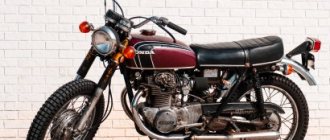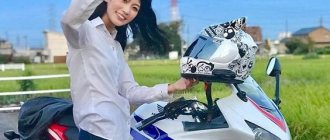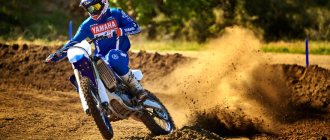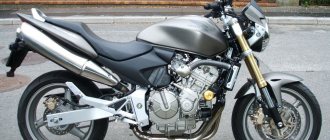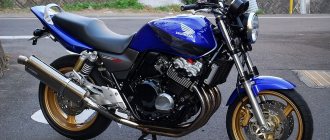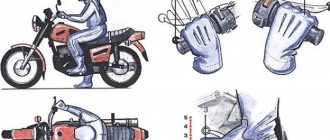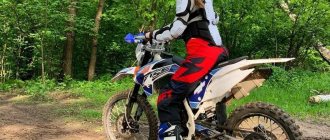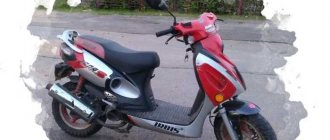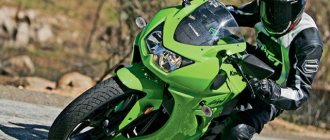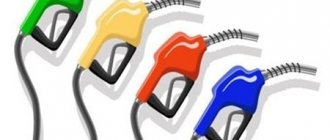In our country, a motorcycle plays the role of a two-wheeled friend “for the soul.” If in some India, Vietnam, China, a bike is used forcibly, transporting all family members, furniture and pets at the same time, then here it is purchased precisely for pleasure. The criteria for choosing a motorcycle are different for everyone - to get to work faster without traffic jams, to pick up girls, for traveling, to mix up dirt off-road, for “shooting” around the city at night, etc.
Choosing the first bike
If you are a beginner, we do not advise you to start immediately with a large cubic capacity. The choice of your first motorcycle should be based on safety considerations. It is necessary to understand the principles of driving a bike, learn the traffic rules well, and distinguish the difference between riding a car according to traffic regulations and driving a two-wheeler.
But there is a difference! A car is a large vehicle. It is clearly visible on the road (even though accidents occur regularly). The motorcycle always remains invisible. Even bright clothes don't help. It is very important for a beginner to verify this from his own experience. It will also be necessary to learn to predict the road situation “several moves” ahead.
All motorcyclists know that large cubic capacity and explosive nature provoke the pilot to break the rules. While an experienced rider can afford this, a beginner cannot yet react so well. His reflexes are not sharpened, his skills are still not enough. But there is more than enough ambition! Therefore, we recommend choosing a 125 cc vehicle as your first motorcycle. Here are a few of its advantages:
- You can open category A1 for legal driving under additional traffic regulations at the age of 16;
- These bikes are relatively inexpensive, both new and used;
- They are very cheap to maintain;
- They “eat” very little fuel;
- Consumables and spare parts can be found even in the outback;
- One or two seasons is enough to master the necessary motorcycle riding skills;
- If you buy a used Japanese motorcycle, for example, the legendary Yamaha YBR 125, then you can sell it at the same price without losing money.
Seat height is more important than weight
You can often hear someone say that they cannot handle, for example, a large cruiser, because such a car weighs up to 300 kg. And while some strength is indeed helpful, they are also suitable for shorter people. Moreover, cruisers are among the most versatile motorcycles in terms of rider height.
This is because the key issue is seat height and the ability to stand firmly on the ground when stopping. If both provide strong support, even a large machine can be easily handled. However, if you only reach the ground with your fingers, parking maneuvers even on a lighter motorcycle can cause you to tip over. Therefore, it is worth remembering the main rule - if you stand firmly on your feet, you can handle the motorcycle.
Choosing a motorcycle by height
Height is an important factor that directly influences the choice of motorcycle. Saddle height varies depending on the type of bike. Thus, off-road motocross and enduro motorcycles are distinguished by high ground clearance and enormous suspension travel. They are very high in the saddle, but in this sport this is justified: the pilot almost always stands above the motorcycle, and “catches” it with his foot only in sharp turns. At the same time, such a tall bike is not suitable for riding around the city. Numerous traffic lights, crossings, and intersections force the pilot to stop regularly. Ideally, he stands firmly with both feet on the asphalt. This is the safest option, allowing, if something happens, to “catch” a falling bike by pushing off with your foot. Uneven roads, an occasional hole, a slope, sand, dirt on the side of the road - all this requires confidently holding the motorcycle at a speed of zero km/h. Of course, you can ride on any two-wheeler. Many pilots only lightly touch the asphalt with the toe of one foot. But this option is unsafe. And taking a passenger on board without being able to firmly hold the motorbike is generally irresponsible.
Therefore, when choosing a motorcycle, you definitely need to “try it on”. Or at least use the website https://cycle-ergo.com, where you can do this virtually by choosing a brand and indicating your height parameters.
What should a short motorcyclist do?
- Suspension adjustment
- Seat replacement
- High-soled shoes
- Selecting a different motorcycle model
Choosing a different motorcycle model is a position that solves the problem at its inception. If the motorcycle is too tall, then it is logical to look for something more suitable. You will have to try the fit on many models before you find the one that is perfect. However, it happens that a person with all his heart wants to own a certain motorcycle, which means he has to put up with its features - change it to suit himself.
The easiest way out, as we have already said, is to adjust the suspension . You lower the motorcycle using all available methods. Some don’t even skimp on replacing the wheel radius, but this is already a radical way to adjust your favorite model to your height.
Replacing the seat or re-flashing it in order to lower the seating position itself is the second most popular way to customize a motorcycle. Some dealers offer ready-made replacement seat solutions for every taste and budget, so to speak. Some people bother and remake the seat themselves, others simply order the seat reupholstered with the condition that it will be lower. The height of the seat, its shape and fastening affect the fit. By the way, you might want to brush up on some trivia about seating: “Seating and weight distribution on a motorcycle are half the success of a good motorcyclist.”
Shoes with high soles or a special platform are rare among motorcycle shoes. Therefore, motorcyclists who decide to go this route either spend a long time looking hard for the right shoes, or make a special order. In any case, such sophistications will take a lot of time.
At first, even a motorcycle that suits your height may seem tall, but this is all cured by experience. When you get used to moving a tall motorcycle from place to place or getting on/off it, the problem ceases to be acute. By the way, with new shock absorbers the motorcycle will feel higher, because with worn shock absorbers it will sink more under you. Consider how easy it is for you to get on and off the bike before purchasing. It's little things like these that make up a successful season for a motorcyclist of any skill level.
Selecting a bike for the city
Choosing a city motorcycle is quite simple. There are a lot of models like Street or Classic. They are easy to recognize regardless of brand due to several features:
- Small amount of plastic;
- Average or even low saddle height;
- Smooth, almost straight landing;
- "Road" tires;
- Excellent handling and maneuverability.
They come in different cubic capacity and power. There are small-capacity bikes, such as the Yamaha YBR 125 or Suzuki Bandit 250. There are more powerful ones - the Honda CB 400 SF, proven over decades, or the Kawasaki W650 retro bike.
In principle, motorcycles of other classes may be suitable for the city. True, riding sports cars like the Yamaha YZF R1 or Honda CBR 600 RR on city streets is extremely inconvenient. The “recumbent” landing, the explosive operation of the engine, the need to “turn” it require a racing track, and not streets with intersections, traffic lights and active traffic.
Which model is better for the city?
You have decided to take a model for urban conditions and have no plans (in the near future) to get out on the highway. Or you just don’t want to use a bike that’s too fast. In this case, the choice of motorcycle comes down to the following models:
- The KTM Duke 690 is bold, contrasty, but has a great riding position (no need to reach for the handlebars for long thanks to the small tank). It is also narrow, which makes it easier to maneuver in city traffic, and is characterized by low power and light weight. Very reminiscent of a typical 125 cc model, although it is not one (it is larger). Optimal speed is about 125 km/h;
- Honda CB600FA is comfortable, convenient and lightweight, with a stylish design. It has an improved design, modern technical features and a medium engine size. Well suited not only for beginners, but also for experienced bikers;
- Yamaha MT07 - has excellent traction and acceleration, weighs 180 kg. In general, an ideal option for the city, although it may be a little difficult to learn for beginners;
- Kawasaki ER6-N (aka “Ruff”) - attractive price, unusual design, comfortable fit. In terms of technical characteristics, it is a well-balanced option. It would be ideal if the steering wheel weren't too wide, making it difficult to maneuver between cars;
- Yamaha XJ6N is a mid-sized station wagon for leisurely riding with simple controls. Perhaps the best option if you are interested in urban models.
Choosing a bike for travel
The choice of a touring motorcycle sooner or later concerns everyone who is about to go on a trip. Ideally, a long-distance bike should meet the following criteria:
- Have a comfortable fit with a straight back;
- Have a soft suspension, moderately high ground clearance for overcoming country roads;
- Have good wind protection;
- Be hung with various trunks, bags, trunks (optional, you can finish it yourself);
- The volume of the fuel tank and gasoline consumption should allow you to ride the motorcycle for as long as possible (300-500 km from refueling to refueling);
- Ideally - ABS. This improves security. And long-term driving on the highway somehow dulls the reaction and reflexes of the pilot;
- The weight and size of the bike must be such that if it falls, the pilot can pick it up without assistance.
With or without a cardan is an eternal question regarding touring motorcycles. The presence of a cardan allows you to travel tens of thousands of kilometers without unnecessary worries. While chain maintenance is necessary every 500-600 km, as well as after every rain or wash. In this case, the cardan, which has served its life, will have to be replaced entirely - and this will hit your pocket very hard. While a chain with stars costs pennies, and you can change them even in the field “on the knee”. Here everyone makes a choice for themselves.
Classic “tourists” include BMW R1200GS , BMW R1200RT, Triumph Trophy 1200, Kawasaki Vulcan 1700 Voyager, Honda Gold Wing, and some other Honda and Yamaha motorcycles. Cruisers have also proven themselves to be good for tourists, allowing them to stretch their legs and relax on a long journey.
When choosing a motorcycle, remember that the best long-distance bike is the one you already own. It’s better to go on a trip in a small-capacity or road-going vehicle than not to go at all, saving money for years for the equipment of your dreams.
Choosing a motorcycle for a beginner
If we have already decided on the main selection parameters, then all that remains is to go through specific models. So, choosing a motorcycle for a beginner consists of the following - selecting a suitable model from several:
- The Suzuki GS500F is a good option for a sportbike if you are interested in the sporty component of biker life. Fast, powerful, comfortable, with adequate control and good dynamics. However, it may be too fast for an untrained driver - it accelerates to 100 in 4 seconds “plus”;
- Honda CB 400 SF is a good option for beginners. Responsive control, low power (up to 53 hp), volume up to 400 cubic meters. A good and fairly lightweight option, but it is extremely difficult to find such a bike outside of Japan, because it was produced for the domestic market;
- The Kawasaki Ninja 500R is quite cheap, consumes fuel economically, is easy to control, and is very stable when cornering. So - all advantages, if you look at safety;
- Suzuki DR200SE is a kind of SUV for a beginner. Able to go in a direction where it is difficult to get through on foot. In addition, it is very light, so even if it gets stuck, you can easily pull it out on your own.
A bit of a shock for newbies, the chopper is also suitable for those trying to learn bikes. They have a comfortable and very convenient fit, and are very unpretentious to driving skills. Yes, they cannot reach “cosmic” speeds, but they are firmly positioned with experienced bikers. There are only two models to study here - the Honda VT750C Spirit or the Suzuki GZ250 Marauder. Reliability, power and a guarantee that even an inexperienced driver will get to the end point of his trip (even if it is in another city). By the way, choppers also look extremely stylish, so choosing a motorcycle of this type is completely justified.
Does it make sense to take dockless?
We strongly advise you not to choose a motorcycle without documents. This choice brings with it many inconveniences:
- There is a risk that the bike is stolen - you will be considered an accomplice;
- The vehicle can always be “squeezed out”, stolen, you will never be able to contact law enforcement agencies, put on the wanted list and generally prove that this is your equipment;
- The traffic police will always be interested in people without docks. You will not be able to calmly go to a rally, or go on a motorcycle trip, or ride in a convoy to the opening or closing of the season. The fear of the law will always be present;
- If you get into an accident, you will always be at fault, no matter how fast you were driving or who should have passed whom. You simply did not have the right to be at additional traffic police stations in an unregistered vehicle.
Registering a motorcycle is a simple procedure and will not take much of your time. The main thing is to initially buy a “clean” bike, check it by frame number, get a certificate-invoice or draw up a sales contract. But after this you can be confident and calm. Which also increases reaction and safety on the road.
The choice of motorcycle is very important. Take this seriously, and then you will only enjoy driving!
Help for a new biker
To reduce purchasing problems, when choosing your first used motorcycle, you should pay attention to the following:
- Check the year of manufacture in the documents with the real one. To do this, look at the documents and study the brake hoses and discs - the year must match. If it doesn’t match, then it’s time to ask the seller why (if there are no problems, then they will tell you in advance that the bike was damaged and you had to put in what was found);
- Motorcycle registration. Check if everything is in order with these documents. By the way, after purchasing, immediately register it in your name;
- Inspect the appearance - if the bike has been used, it has been dropped and there should be scratches. If it was actively used and they were not, then they were hidden. This means they could have hidden something more serious;
- Look in the gas tank. There should be no trace of rust on or in it. If they exist, don’t buy them, because this model won’t last long;
- Inspect the frame. There should not be any traces of welding on it, because this already affects the strength of the structure. Of course, if everything is done efficiently. You can take this at your own peril and risk;
- Inspect the chain. No rust, it should not be stretched, the sprockets should not be bent. If everything is in order, then the chain has been serviced regularly and the motorcycle will be able to serve for a long time, otherwise repairs will be needed;
- Inspect the fork. To do this, just press on it several times - no oily marks should appear;
- Start the engine. The engine must start the second time if it does not work the first time. Moreover, without pre-heating. The sound should be even;
- Check the brakes and optics. Turn on the turn signals, turn on the main lights, test the brakes.
You don't even have to look at the speedometer. No one on the used market will ever tell you how many kilometers the bike actually has traveled. Simply because we have too few honest drivers to trust the readings of this device. Even if in front of you is a brand new Kawasaki W650. Therefore, when purchasing used equipment, you should pay attention to the Japanese motorcycle auction. There, all technical conditions are assessed by an independent technical expert.
How does the seating position affect the performance of the motorcycle?
It is clear that your position on the motorcycle does not interfere with the engine or gearbox, but it does affect the weight distribution, comfort and speed of your control.
Everything in a motorcycle is always clearly balanced, thoughtful, verified and calculated, everything except the only unstable element - the pilot and his actions. The load on the suspension depends on our position on the motorcycle, hence the first tip - sit closer to the tank, taking up space above the engine. Sports motorcycle pilots literally lie down on the tank of the motorcycle when accelerating; this is done not only to reduce air resistance. Let me tell you a great secret: the pilot distributes his weight closer to the front of the motorcycle, shifts the center of gravity, unloading the rear suspension. This makes sports motorcycles pick up speed more easily, since the rear wheel does not burden anything. Basically this works with any motorcycle, the less weight on the rear suspension the easier it is for the bike to accelerate.
However, shifting your weight forward can lead to problems in turning. If we unload the suspension, then this also leads to what? Come on, you know the answer! The level of grip is lost, it ceases to be tight, since there is no pressure on the wheel, which means that in turns you really risk getting into trouble if your speed or angle of inclination is too high. In such cases, fans of racing reconfigure the suspension: lower the rear and raise the front.
engine's type
All engines are divided into four-stroke and two-stroke - they differ in the operating cycle.
For a 4-stroke internal combustion engine, the operating cycle consists of four processes: fuel intake; compression; combustion leading to expansion; release.
Such engines perform well in the “middle” range. Even at idle speed they have good airflow (two strokes are spent on this), due to which they have high torque at the start. Despite the weight, 4-stroke internal combustion engines have an advantage in handling. The downside is that at high speeds they are inferior to two-stroke engines.
A 2-stroke internal combustion engine has only two stages: compression and expansion. Purge near the bottom dead center of the piston, at which fresh fuel displaces gas, serves as a replacement for the two remaining strokes.
This type of engine has an advantage when driving at the “top”: with the same volume, it has 2 times more power than a four-stroke engine. A two-stroke engine costs less to maintain, but the problem is poor airflow, which results in poor mid-range torque. Two-stroke engines are sometimes called chainsaw engines because of their similar sound.
